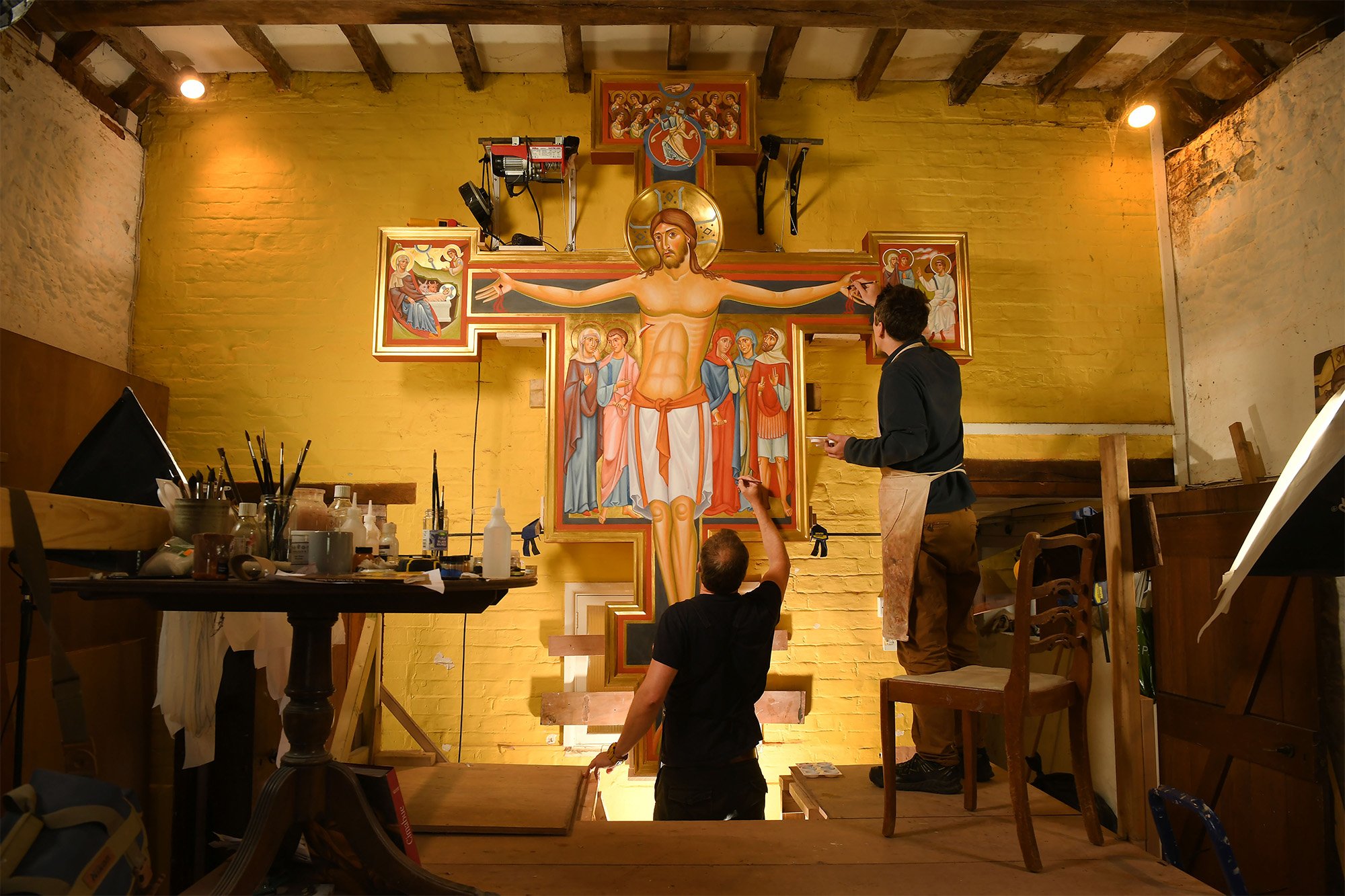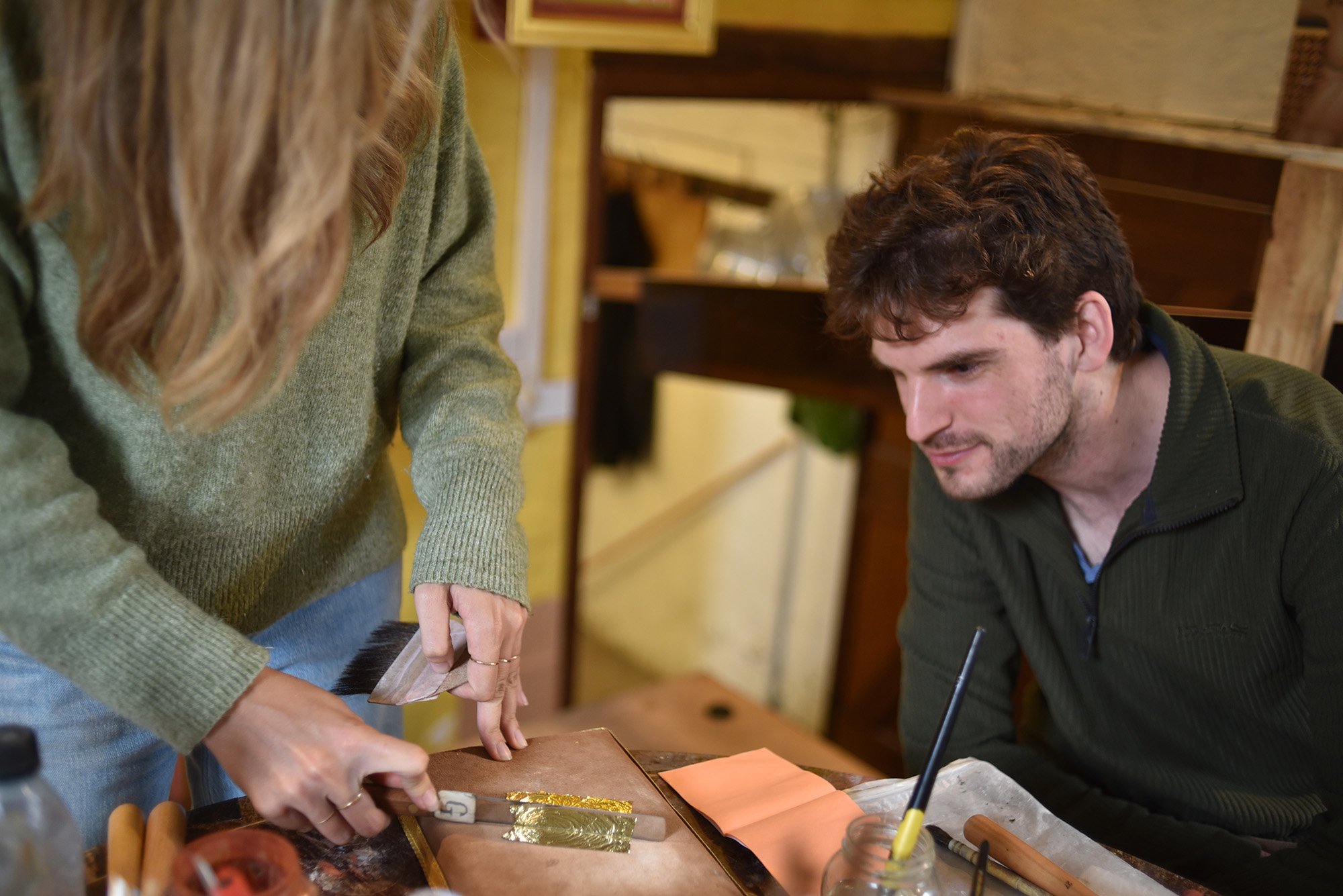By Margarita Mooney Clayton
Standing in front of a 10-foot-tall icon he painted based on the San Damiano Crucifix, the English Catholic artist Martin Earle commented that the most satisfying part of making this sacred object was not the product itself, but the sense of community he developed with the various apprentices working alongside him. This desire for a community of liturgical artists led Earle, along with his own Master teacher Aidan Hart and one of his former apprentices, James Blackstone to found The Chichester Workshop for Liturgical Art. By working with side-by-side with apprentices on their commissions, these Masters pass on both the skills and the theology of liturgical art.
Martin Earle and Jim Blackstone working on the crucifixion based on the San Damiano crucifixion.
On September 14, 2023, I traveled to Chichester, where the Anglican Bishop of Chichester (the patron of the project) and the Roman Catholic Bishop of Arundel and Brighton gathered to bless the workshop. “Sacred art is profoundly ecumenical,” Anglican Bishop Martin Warner said, “as all Christians believe in sacred space, sacred time, sacred people and sacred objects.”
At the workshop, I naturally took delight in the beauty around me. But how did hearing about Earle’s experience help me understand Bishop Warner’s remarks about how sacred objects form Christian communities?
In a recently published book entitled The Shape of the Artistic Mind: A Search for the Metaphysical Link Between Art and Morals in the Thought of St. Thomas Aquinas, Fr. Brad Elliott, OP, describes two distinct registers by which philosophers, from Plato to Kant, have thought about art. For some, the artists’ inspiration is what makes art good, quite apart from any judgment about the qualities of the object made. For others, the perfection of the art itself—such as beautiful classical music—makes art worthwhile.
Drawing on Saint Thomas Aquinas, Elliott argues that, by bringing new objects into being, humans co-create with God. Thus, both art and moral virtue are ways that humans imitate God. By imitating God, we therefore participate in His governance, as He draws all things back to Himself. Hence, art seen as a practical virtue, extends God’s governance over creation. Furthermore, Elliott states that art understood as a practical virtue makes visible the invisible inner world of the human person and the goodness of God.
Martin at work on a mosaic of the Pantocrator
If Elliott is right that making art is part of our shared participation in the governance of God, then isn’t Earle also right that the process of making art should also bring us into community with others who share that purpose? It would be a mistake to think of master-apprenticeship relationships fostered at the Chichester Workshop for Liturgical Art simply as means to the end of having more beautiful liturgical art. The relationships fostered among artists there must also be a highly valued end.
Apprentices gilding
Their example shows why we must never separate the process of making sacred art from the object made. For instance, two of the young apprentices, one man and one woman, who worked alongside Earle during his work on the San Damiano Cross (commissioned for the Catholic Cathedral of Aberdeen in Scotland), beamed with joy as they shared how both their faith and their skills grew while working alongside Earle and Blackstone.
Jim at work on his St Dominic mosaic
In a time when many churches have either plain white walls or walls decorated with art that bears no resemblance to the great Christian tradition of sacred art, the renaissance in liturgical art spearheaded by Hart, Earle, and Blackstone will surely garner attention for the beautiful objects they make. But the personalities of these sacred artists could not be further from the popular caricature of the Romantic attention-seeking, self-aggrandizing, performative artistic persona celebrated in popular culture. Instead, it seemed to me their personalities are more akin to the product of kenosis, a humbling of oneself so the glory of God can shine.
Jim Blackstone
Earle shared over dinner that he did not grow up as a practicing Christian. His love for art and need for God grew alongside each other. He volunteered at a hospital for the disabled in Israel; he also studied at the Royal College of Art. After a brief time discerning a monastic vocation at Pluscarden monastery in Scotland, he discerned that he did not have a calling to be a monk.
Providentially, Earle settled in Shropshire, England, near Hart’s studio. Working alongside Hart on many commissions, Hart trained Earle in a variety of sacred arts—from icons to frescoes, sculpture, mosaic and carpentry. One of his recent commissions was for an icon based on the 13th century mosaic of Christ the Pantocrator in Hagia Sophia in Constantinople. Blackstone, an ordained Anglican minister with a Ph.D. from the University of Cambridge, explained to all of us at the studio blessing how Earle had trained him on his four-feet tall mosaic of Saint. Dominic, which he made for the vestry at Chichester Cathedral to aid the priests in their spiritual preparation for celebrating the liturgy.
Martine Earle
Our culture is full of spiritually hungry people who long for beautiful sacred art. The newly founded Chichester Workshop for Liturgical Art, training apprentices and receiving commissions from Orthodox, Catholics and Protestants alike, is an artistic feeding of the five thousand. We should all be encouraged by these artists who not only have the humility to learn from masters but also the desire to pass on what they have learned to new apprentices.
Our desire for beautiful art must remain connected to the goal of deepening the communion of persons. By establishing a community of artists who are working in harmony with each other and participating in God’s governance of creation, the artists at the Chichester Workshop for Liturgical Art are not only creating beautiful art for Christian churches, but they are also strengthening the harmony among Christians, and helping us all grow in virtue.











